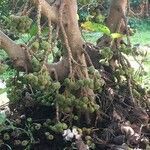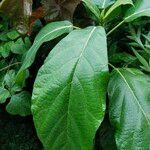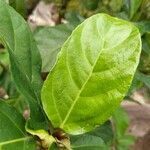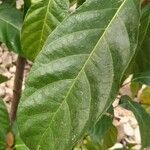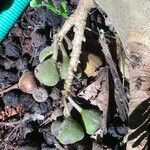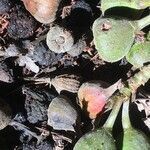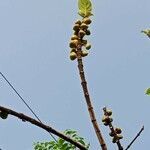Spreading tree to 15 m high, often with slightly buttressed roots; flat gland at junction of stem and petiole. Leaves opposite-decussate, sometimes alternate; lamina pentagonal to oblong or ovate to elliptic but asymmetric, (9–) 15–35 cm long, (4–) 6–20 cm wide, rounded, subcordate to cordate or oblique at base, ± crenulate or serrulate to serrate margin, acuminate at apex, chartaceous, hispid with short white stiff hairs; lateral veins 5–13 pairs, with prominent intercostals; petiole (0.5–) 5–12 cm long, hispid. Figs often cauliflorous in clusters to 1 m long, often trailing, sometimes also a few axillary, depressed-globose, 1–4 cm diam., green, cream or yellow, densely brown-pubescent (or velvety white hairs, fide Cooper & Cooper 2004: 324); ostiole closed by 5–10 bracts; lateral bracts often present; peduncle 5–15 (–24) mm long; basal bracts 3, to 1.5 mm long, pubescent. Male flowers in 1 or 2 (3) rows. Female and gall flowers subsessile to pedicellate; perianth enveloping ovary.
Shrubs or small trees, coarsely hairy; dioecious. Stipules usually 4 and decussate on leafless fruiting branchlets, ovate-lanceolate. Leaves opposite; petiole 1-4 cm, with short thick hairs; leaf blade ovate, oblong, or obovate-oblong, 10-25 × 5-10 cm, thickly papery, abaxially with coarse gray hairs, adaxially rough and with short thick hairs, base rounded to ± cuneate, margin entire or bluntly toothed, apex acute to mucronate; secondary veins 6-9 on each side of midvein. Figs axillary on normal leafy shoots, sometimes on leafless branchlets or branchlets from main branches, solitary or paired, yellow or red when mature, top-shaped, 1.2-3 cm in diam., with short scattered hairs, pedunculate; involucre bracts present; lateral bracts sometimes present. Male flowers: many, near apical pore; calyx lobes 3, thinly membranous; stamen 1. Gall flowers: calyx absent; style subapical, short, thick. Female flowers: calyx lobes absent; style lateral, with hairs. Fl. Jun-Jul.
A fig. It is a small bushy tree. It grows 6-8 m high and spreads to 2-5 m across. The branches are hollow. It has strangling roots but not aerial roots. The trunk is short and fairly straight and slender. The bark is grey. The young shoots are red and hairy. The leaves are alternate and simple. The leaves are 10-35 cm long by 6-12 cm wide. The leaf stalks are 2-9 cm long. The leaves are dark green, thin and rough on both surfaces. The trees are separately male and female. The fig is 3-5 cm across. They are reddish-green and borne in clumps on the trunk and larger branches. The figs split open and are red inside. There are some varieties described based on the colour and size of the figs.
